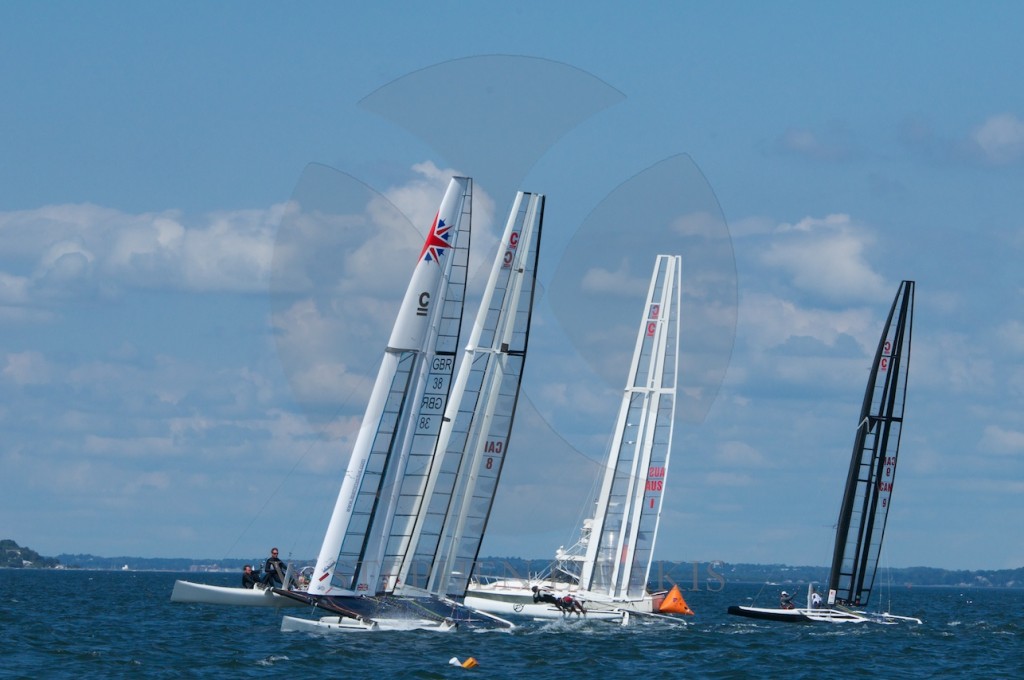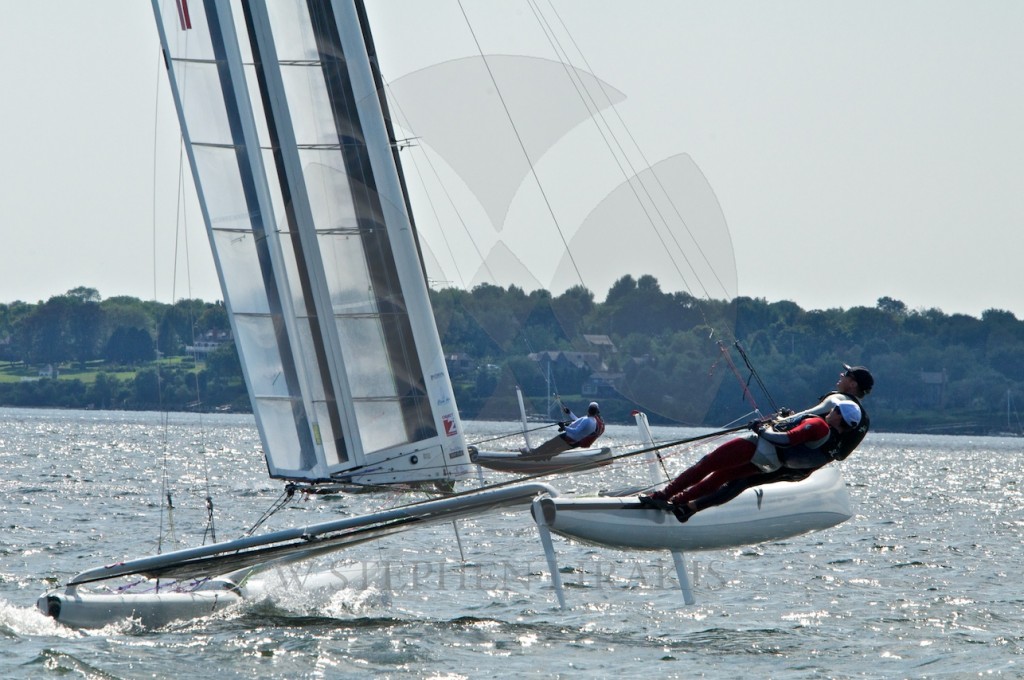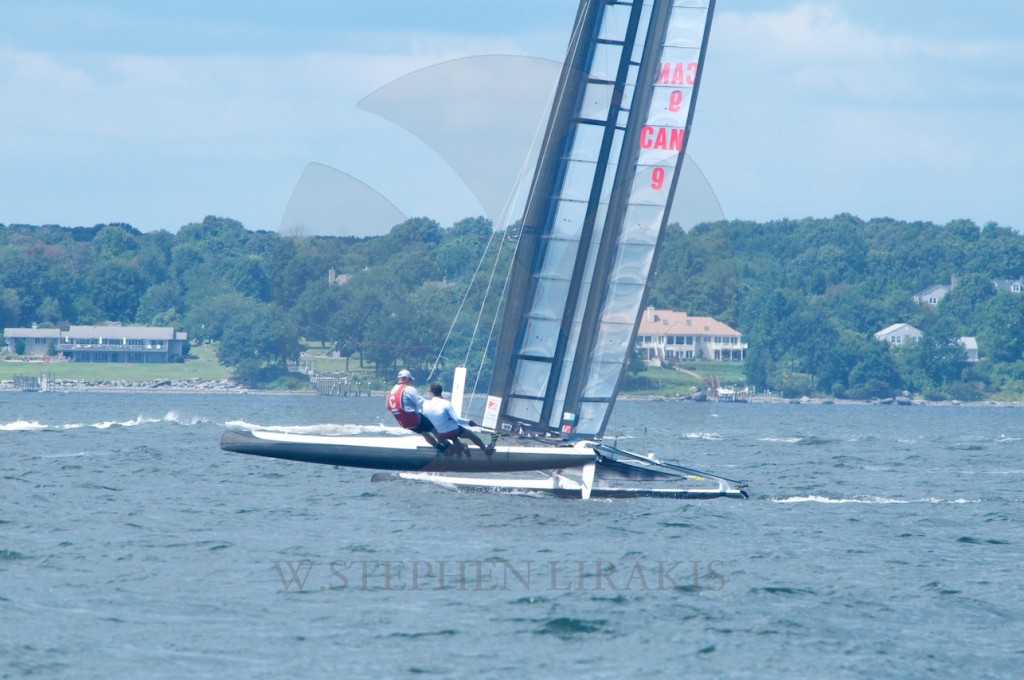Thanks to Sailing Anarchy. This is just too cool
Category: C class catamaran
“C” CLASS CATS FOILING
This is the class that started it all. A few years ago when the world championship was in Newport. Everyone who would potentially be involved in the America’s Cup filed through to look at these boats and learn. And remember Bob Fisher, who is in San Francisco was one of the first to sail “C” class cats; before solid wings and lifting foils of course.
The world championship will be in Falmouth UK in September. This is one of those must see events. I expect to see a record turnout with paul larsen, the world’s fastest man on water sailing a new boat.
FOILING PHANTOM
Foiling is the “new” standard in fast sailing. Hydroptere is the recent big boat success. The America’s Cup it is a must do. the Moth class as well. Can the “C” class cats be far behind? There have been foiling “C” class boats but will it be a must for the upcoming championship in September of this year?



23 September – 28 September
International C Class Catamaran Championship
International C Class Catamaran Championship is a competition for C-Class catamarans that is held every 3 years. The boats are 25 feet long, 14 feet wide, with a crew of two and a 42 feet high solid “wingsail”, they are capable of a spectacular 25 knots. This is the first competition in Britain since the 1960s. First sailed in Britain in the 1960s, the Cup has not been won here for over 40 years. In Rhode Island USA, the 2010 event was won by the Canadian team; The GB team Invictus came third out in a field of seven.
You can expect 16-20 craft taking part in the International C Class Catamaran Championship. This many have never been seen together before; they will come from the US, Canada, Australia, New Zealand, France, Italy, Sweden and Britain. They will practice in the first week, which is then followed by fleet racing and finally match racing between the leading two boats. Each day the boats will sail from Restronguet Sailing Club to the race area and return on completion of racing.
Racing will be in Falmouth Bay or the Carrick Roads, depending on wind and sea conditions. They can be watched from Pendennis Point car park or Trefusis headland if in the Roads and from the water.
COSMIC SHIFT
Hydropetiere set the new standard. Foils are in. To go fast you must reduce wetted surface. Will SpeedDream work as hoped? No matter what sailing has changed dramatically in my lifetime. And the change has accelerated.
Oracle’s L-foil failure on their AC72’s first day out was no minor snafu. With nearly a two-month build time for the hyper-engineered appendages, their engineers and designers must be freaking out right now trying to understand exactly how and why such an important structure broke. With the foil carrying more than half the weight of the boat in fully foiling conditions, it’s akin to a brand new Formula One car losing its front wheels on the first-ever test lap. Like Artemis’ expensive and time-consuming wing failure and repair, Oracle could be looking at the loss of a ton of development time exactly when they need it most: When the breeze is pumping through the Golden Gate. We’ll see what the spare looks like – it’s very easy to stay posted on the up-to-the-minute action with all the boats here.
ETNZ seems to be getting the most out their Auckland testing with minimal drama, but it’s worth noting that these boats are all just one bad decision away from having a long repair bill, especially when they’re doing 40 knots, 4 feet above the water’s surface, held up by just two tiny blades of carbon. For anyone still wondering if ‘fully foiling’ is nothing but a head fake, we turn to resident C-Class mastermind ‘blunted’ – who’s been down the foiling road before with the C-boat Off Yer Rocker.
Clean speculated once that we built ‘off yer rocker’ as a head fake. Well if it was, it was a really expensive practical joke, on us. Suffice to say it was not intended that way by our team. We were chasing some very “real” benefits on the course. We just did it wrong.
I’ve never really said it publicly till now, ‘cause everyone knows I am “the wing nut” and I get all hot and bothered about wings, but from about 4 seconds after the AC72 rule was cast everyone who was anyone knew the design race would be won in the water with foils, not in the air with wings. You only need to look at a few rudimentary VPP graphs to see the difference between foiling and floating to know that you want to fly as much boat as you can, because the drag goes up so fast in float mode and it goes up a lot slower in foiling mode. The big problem is control, because the Rule does not allow actuated surfaces [like a moth’s flaps –ed] to control ride height you have to figure out how to manage the whole package to keep it on its feet, in a safe enough mode you can put your foot on the pedal.
We went back to traditional in the C for a couple of reasons; the biggest being that it didn’t work in our chosen configuration. I am not convinced the C-cat has enough power to make it work well enough at all, at least for Fredo and I, cause of how we like to sail the boat downhill. The 72’s can unfurl a nice big code zero and that offers a lot of power to get up on the foils efficiently, now the trick is to ride a bike with no handlebars so to speak. Foiling without automatic ride height control really is, “Look ma, no hands!”
My guess is the focus on foiling will be downhill as upwind they may have to trade away too much righting moment to make it worth it. I haven’t seen any real numbers recently so it’s difficult for me to say either way. For righting moment remember that your foil as it kicks in essentially moves the center of floatation of the hull towards the middle of the foil. When 100% up on a foil the boat is rotating around a point between the middle of the upright foil and the horizontal foil, well below and inside the center of actual buoyancy. As such you lose some leverage and therefore lose righting moment so you can apply a bit less power, so the trade off needs to be worth it to go for it.
So yes, my vote is anybody who is serious will be foiling, as soon as they are going downhill.
09/04/12
THE “C” CLASS IS NOT DEAD
I am more excited about the “C” class than the America’s Cup catamarans. Of course the America’s Cup ultimately sucks all of the oxygen out of the room; but the “C” class is where the fun is. I will be watching to see if the interest spreads to other countries.
The regatta a few years ago in Newport, had many of the America’s Cup sailors and designers scrambling to learn what they could about catamarans and solid wings. There was a lot of conversation at the time for the potential of the Cup influence to ruin the “C” class. I think many in the class breathed a sign of relief when the AC group moved on.
Multihulls back in the Olympics, the America’s cup Where?
ISAF has provisionally voted to re-include a multihull in the Olympics. It might seem obvious to many of us that there should be multihull in the Olympics given the direction sailing seems to be heading. Even the America’s Cup will be in multihulls next time.
Where will be America’s Cup be held? It depends on which day you ask who. Naturally Larry Ellison cannot shun San Francisco. Is is really a good venue?
Valencia constructed at great cost a purpose built port and facilities. Who knows exactly what else had been promised.
Italy, have no firm plans but are prepared to act; afterall the challenger of record is Italian.
Finally, some words worth pondering from Paul Henderson:
Henderson said:
“Unfortunately.we have taken the fun out of the game and made it too
technical–too much emphasis on boat speed. Sailboats should be no more
expensive than the cost of a second car.and the time spent fixing them
should be one hour for every ten hours on the water. In my opinion it is the
pro’s desire to win at all cost without respect for the sport that has
caused our problems.”
Henderson felt boats should be:
– Gender-equal
– Last a long time
– Keep their value
– Be tactical – not technical
– No trapezes
– Heavy one-designs–not sensitive to crew weight
– Sails that last at least a season
– Sailmakers should not be allowed to use their own sails
Henderson felt races should be:
– Geared to new reality of two income family & need for quality family time
– Races start from front of YC not requiring 10-mile sail for upwind start
– Should race on week nights, leaving weekends free
Henderson said:
“We all seem to have forgotten what sailing is all about. It should be
fun–good racing, good food .and a drink at the yacht club. The best day you
can have in your life is two great races, back to the club to smile a lot,
rehash the races and join together with other sailors who will become your
lifelong friends.”
catamarans vs. monohulls for the America’s Cup
 |
| close racing upwind |
 |
| close racing downwind |
 |
| “C” class match racing |
 |
| “C” class fleet start |
After watching yesterday’s performance by the women match racing it is hard to imagine that if they had been sailing catamarans could have been as close. As intense certainly, but even after having watched the “C” class cats a few weeks earlier, which are small and quite maneuvreable, they accelerate quickly with the wing sails; I am not yet ready to accede to the notion that match racing in catamarans would be as nimble. I will also agree that it is essentially uncharted territory. We have had a very long time to develop strategies in monohulls.
We will not turn back the clock. The next America’s Cup will be in catamarans. This is a decision that may well effect the future of sailing as we know it today.
More "Little America’s Cup
This is a clip put together by Sailing Anarchy. They manage to do such a good job.
I will add that I had a conversation with Bob Fisher, while he was here watching the “C-class cats, that leads me to believe that the words “Little America”s Cup were first used in the sixties. This would, I believe make it a legitimate phrase.
C-class catamarans are in Newport
This is thanks to Sailing Anarchy.
C-class August 27 2010
 |
| harbour court 8 27 10 |
 |
| “Invictus” airbus team |
 |
| match race, “canaan” “orion” |
 |
| tug of war |
A morning northerly and sunshine greeted everyone. It seemed to reflect the spirits ashore. The top two boats were paired in match racing, “Canaan” is so fast, even if Glen Ashby and James Spithill won the start they were hard pressed to keep control.
A little to windward of the start two tugs gave meaning to the words “tug of war” as they pulled against one another with force; to what end was unclear.
 |
| guy gurney, bob fisher, dan nerney, b. hovey |
It seems more and more likely that the next America’s Cup will be sailed in 72 foot catamarans, in Valencia, Spain.
